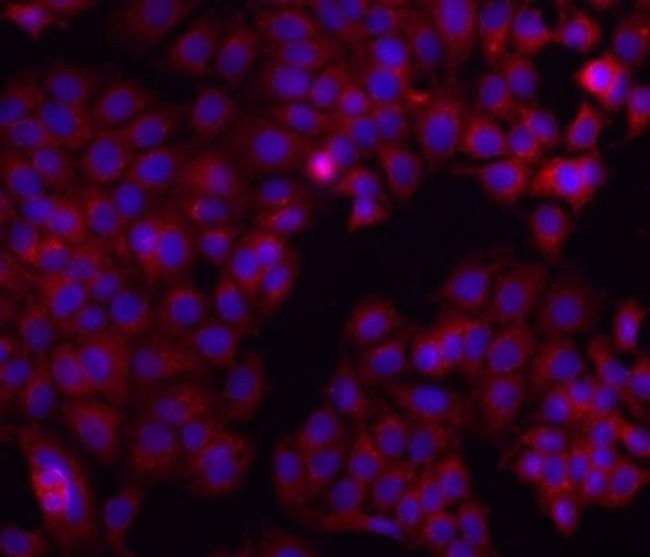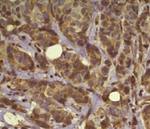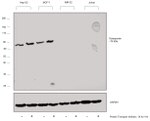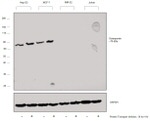Search Thermo Fisher Scientific
Invitrogen
Osteopontin Monoclonal Antibody (2F10), eBioscience™
This Antibody was verified by Relative expression to ensure that the antibody binds to the antigen stated.
Product Details
14-9096-82
Species Reactivity
Host/Isotype
Class
Type
Clone
Conjugate
Form
Concentration
Purification
Storage buffer
Contains
Storage conditions
Shipping conditions
RRID
Product Specific Information
Description: The 2F10 monoclonal antibody recognizes human osteopontin (OPN), a secreted glycophosphoprotein expressed by multiple cell types, including leukocytes, fibroblasts, dendritic cells, macrophages, myoblasts, bone-forming cells, and epithelial cells. OPN is an extracellular matrix protein with multiple roles, including bone resorption and calcification, immune system regulation, wound healing, and tumorigenesis. Thrombin cleavage of OPN allows binding of integrin receptors, expressed by immune cells, and subsequent modulation of cell adhesion, migration, and survival. OPN is expressed in bones, teeth, placenta, blood vessels, kidney, and various tumors. Osteopontin has been identified as a potential therapeutic target in the treatment of autoimmune disease, cancer metastasis, bone mineralization diseases, and osteoporosis.
Applications Reported: This 2F10 antibody has been reported for use in western blotting, immunohistochemical staining of formalin-fixed paraffin embedded tissue sections, and immunocytochemistry.
Applications Tested: This 2F10 antibody has been tested by immunohistochemistry of formalin-fixed paraffin embedded human tissue using either low or high pH antigen retrieval and can be used at less than or equal to 5 µg/mL. This 2F10 antibody has been tested by immunocytochemistry of either methanol-fixed or formaldehyde-fixed and permeabilized human cells and can be used at less than or equal to 10 µg/mL. It is recommended that the antibody be carefully titrated for optimal performance in the assay of interest.
Purity: Greater than 90%, as determined by SDS-PAGE.
Aggregation: Less than 10%, as determined by HPLC.
Filtration: 0.2 µm post-manufacturing filtered.
Target Information
Osteopontin is an arginine-glycine-aspartic acid (RGD)-containing glycoprotein that interacts with integrins and CD44 as major receptors. It is a multifunctional protein involved in bone mineralization, cell adhesion, cell migration, chronic inflammatory disease and transformation. Proteolytic cleavage by thrombin and matrix metalloproteinases close to the integrin-binding Arg-Gly-Asp sequence modulates the function of OPN and its integrin binding properties. Thrombin-cleaved fragments of Osteopontin are overexpressed in malignant glial tumors and provide a molecular niche with survival advantage and provide a novel substrate for plasmin and cathepsin D.
For Research Use Only. Not for use in diagnostic procedures. Not for resale without express authorization.
References (0)
Bioinformatics
Protein Aliases: Bone sialoprotein 1; Bone sialoprotein 1 (BSPI/BSP1); CALPHA1 fusion; Early T lymphocyte activation 1 (ETA1); early T-lymphocyte activation 1; HGNC:11255; immunoglobulin alpha 1 heavy chain constant region fusion protein; MGC110940; Nephropontin; Osteopontin; osteopontin/immunoglobulin alpha 1 heavy chain constant region fusion protein; Secreted phosphoprotein 1; secreted phosphoprotein 1 (osteopontin bone sialoprotein I early T lymphocyte activation 1); secreted phosphoprotein 1 (osteopontin, bone sialoprotein I, early T-lymphocyte activation 1); Secreted phosphoprotein 1 (SPP1); secreted phosphoprotein 1 variant 6; SPP-1; SPP1/CALPHA1 fusion; urinar; Urinary stone protein; Uropontin
Gene Aliases: BNSP; BSPI; ETA-1; OPN; PSEC0156; SPP1
UniProt ID: (Human) P10451
Entrez Gene ID: (Human) 6696

Performance Guarantee
If an Invitrogen™ antibody doesn't perform as described on our website or datasheet,we'll replace the product at no cost to you, or provide you with a credit for a future purchase.*
Learn more
We're here to help
Get expert recommendations for common problems or connect directly with an on staff expert for technical assistance related to applications, equipment and general product use.
Contact tech support




